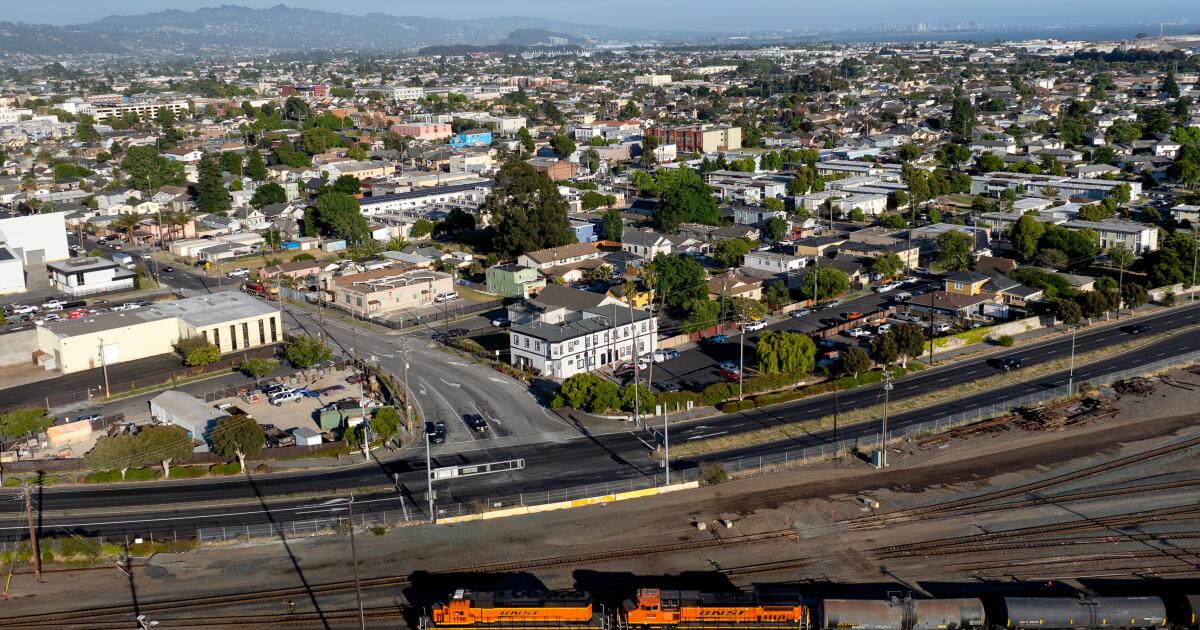Business
This California city lost its daily newspapers — and is living what comes next

For years Richmond City Councilmember Cesar Zepeda has been on an unsuccessful crusade to persuade the grocery store chains of America — or at least one of them — to bring a supermarket back to his industrial city on the edge of the San Francisco Bay.
He’s persistent. He’s called corporate headquarters. He’s emailed customer relations. Occasionally, he’s gotten executives on the phone, and listened to them stammer on about why Richmond isn’t the right place for them to locate a store, despite its population of 117,000 in the heart of the Bay Area.
After years of disappointing conversations, Zepeda has concluded something basic about his city: It is paying a big price by not being able to tell its own story.
Richmond has not had its own daily newspaper for years. The loss came during a period of profound struggles for the town, which has dealt with fluctuating crime, economic problems and environmental challenges. Zepeda and others say there is a lot of good and bad going on in Richmond, but the dearth of local news coverage offers a skewed view of the city — oversimplified and years out of date — as an impoverished and violent community.
“The lack of coverage puts us into deserts of everything. We have a hospital desert. We have a grocery store desert,” Zepeda said. “Just the lack of any coverage, it affects the perception.”
In this news desert, the main information source has been the Richmond Standard, a news website funded by Chevron, Richmond’s largest employer. It offers reports on youth sports, crime logs and things to do in town. Recent articles have highlighted a mural project, a car caravan supporting racial justice and upcoming closures to Interstate 80.
But the Standard is conspicuously silent when it comes to hard-hitting reporting on the Chevron refinery, which activists blame for the city’s high rates of hospitalization for childhood asthma. On June 19, the City Council voted to put a measure on the November ballot asking local voters to levy a tax on the refinery that would generate tens of millions of dollars a year to be used as the city sees fit. The lead-up and follow-up to this hugely consequential development were nowhere on the Standard’s homepage.
Richmond is one in a swelling number of California communities that in recent years have had to navigate civic life without a traditional newspaper. The city — a onetime shipbuilding hub that fell on hard times and is now in the midst of a rebound — was once served by multiple papers, but the grim economics took them out one by one.
All the while, in-depth daily coverage of Richmond, a city with 23 distinct neighborhoods and cutthroat politics, with a refinery of vital importance to the state’s energy economy, shrank and shrank.
“The lack of coverage puts us into deserts of everything. We have a hospital desert. We have a grocery store desert.”
— Zepeda Richmond City Councilmember Cesar Zepeda

Councilmember Cesar Zepeda says the dearth of local news coverage in Richmond has resulted in a skewed portrayal of his city, making it harder to draw retailers.
(Josh Edelson / For The Times)
The issue of California’s growing news deserts — and the fallout on civic engagement — has become a heated topic in the state Legislature, where Assemblymember Buffy Wicks (D-Oakland) is pushing a measure, Assembly Bill 886, that would require leading social media platforms and search engines to pay news outlets for accessing their articles, either through a predetermined fee or through an amount set by arbitration. Publishers would have to use 70% of those funds to pay journalists in California. Lawmakers are also considering state Senate Bill 1327, which would tax large tech platforms for the data they collect from users and pump the money into news organizations by giving them a tax credit for employing full-time journalists.
AB 886 is sponsored by the California News Publishers Assn., whose members have argued for years that online search engines and social media platforms are gutting the newspaper business by gobbling up advertising revenue while publishing content they don’t pay for. (The Los Angeles Times is a CNPA member, and its business leaders have publicly supported the measure.)
The legislation has drawn staunch opposition from Google and other tech companies, which contend it would upend their business model.
The rise of the search engine is one of many factors pushing California newspapers out of business. Richmond’s news decline began well before eyeballs and advertising migrated online.
But Richmond’s story is not just about the loss of news. It also shows how a community gets information in a post-newspaper world.
Richmond is now a laboratory for online journalism startups, including the one owned by Chevron, whose massive refinery looms over the city and has been the focus of ongoing concerns over toxic emissions.

Protesters rally in support of putting a measure on the November ballot that would levy a new tax on Chevron’s refinery, generating millions of dollars annually for city coffers.
(Josh Edelson / For The Times)
The region’s independent online publications are sometimes hard-hitting and admirably hardworking, but they are limited in size and reach. The students at UC Berkeley’s journalism school operate Richmond Confidential, a news lab for student reporters that is funded by a grant from the Ford Foundation. Since late 2020, the husband-and-wife team of Linda and Soren Hemmila have put out the Grandview Independent, whose website proclaims: “For us, there is no story too small.”
There is also a youth-focused site, the Pulse, and a publication that focuses on the area’s Black community. In late June, the team behind the well-regarded local news websites Berkeleyside and Oaklandside launched a sister publication called Richmondside.
Still, said City Councilmember Doria Robinson, “the unfortunate best source” for much of the day-to-day goings on in recent years has been the Richmond Standard.

Councilmember Doria Robinson finds it troubling that Richmond residents get their daily news from a site funded by Chevron, the town’s biggest employer and a source of controversy.
(Josh Edelson / For The Times)
Robinson is a third-generation Richmond resident who was elected to the council in 2022 and for years before that ran a nonprofit farm in North Richmond. She said she is grateful for the work of all the reporters laboring on a shoestring to bring news to her city. But it doesn’t replace the weight and influence of the local paper she remembers from her youth.
And as for the Chevron paper, she said: “It is just unfortunate to have to depend on a project that is openly and proudly funded by our local petroleum [company].”
In 2011, the news group that owned the West County Times made an announcement that had become all too familiar to Richmond readers: More layoffs and cuts were coming to the chain that published the West County Times along with several other outlets in the East Bay. There would be less news out of Richmond.
Former Councilmember Tom Butt, who sends out an email about Richmond that doubles as an informal newsletter, lamented the decision and urged citizens to complain, writing: “What will this mean for Richmond? Undoubtedly, it will mean reduced coverage of local news.”
Five years later, in 2016, the ax swung again, and the West County Times was merged, along with a number of other newspapers, into two. Another chunk of the reporting staff was cut.
“The level of connection we were able to maintain with people in the community really evaporated in a significant way,” said Craig Lazzeretti, a journalist who covered the region for 30 years, much of it in Richmond. Over time, Richmond lost its education and public safety reporters, he said, and while City Hall remained a priority, coverage of sports and entertainment also declined.
In its heyday, the coverage was rigorous, and “it did play a significant role” in civic life, Lazzeretti said. “You had a lot of strong political personalities in Richmond.”
He admits the local newspapers of that era were not perfect: “We were covering an ethnically diverse city, and there wasn’t a lot of ethnic diversity in our newsroom.” But reporters did try to reflect what was going on in the city.

The Richmond-San Rafael Bridge spans San Francisco Bay, connecting Contra Costa and Marin counties.
(Josh Edelson / For The Times)
As the 21st century dawned, the West County Times, the lone paper still covering Richmond vigorously, was facing a menacing economic shift: the rise of the internet. Advertising dollars — long the financial mainstay of traditional newspapers — moved online, budgets dwindled, and soon there were almost no reporters left to cover Richmond on a daily basis.
Meanwhile, life in Richmond was entering a dark period. The city’s better-paying manufacturing and industrial jobs were evaporating because of economic shifts, spawning an exodus of middle-class earners to the suburbs.
Chevron, which had long been one of the biggest influences on local politics, stayed. But as concerns mounted about the effects of its refinery on air quality, progressive candidates began organizing to counter the weight of the oil company.

The Richmond Standard, funded by Chevron, has been conspicuously silent when it comes to hard-hitting reporting on the company’s refinery.
(Josh Edelson / For The Times)
By 2010, candidates backed by the Richmond Progressive Alliance had pressed the company to contribute more fees to the city to compensate for environmental damage. And then came the disaster of August 2012, when a corroded pipe at the refinery sprung a leak, igniting a series of fiery explosions that shrouded the East Bay in choking black smoke. More than 100,000 people were ordered to shelter in place, with windows and doors sealed shut, and thousands sought medical treatment after inhaling toxic air.
The episode set off a wave of activism that included investigations into Chevron’s operating practices. In August 2013, Chevron agreed to plead no contest to criminal charges stemming from the fire and pay $2 million in fines.
Five months later, on Jan. 23, 2014, Chevron launched the Standard.
“We think it’s good for us to have a conversation with Richmond on important issues, and we also think there are a lot of good stories in this city that don’t get told every day,” the company wrote to readers in announcing the news site.
Progressives were alarmed: The entity that in their eyes most needed watchdogging was now a leading source of local coverage.

Tina Szpicek rallies in support of a November ballot measure that would levy a new tax on Richmond’s Chevron refinery.
(Josh Edelson / For The Times)
Still there was now a reporter roaming the neighborhoods, reporting on a new baseball field, a burglary, local businesses and even some local politics.
In June, while the Standard ignored the City Council’s vote on taxing the refinery, it did cover a Little League triumph, a shooting that left two people dead and the schedule of movies to be screened this summer at “Movies in the Park.”
Ross Allen, a spokesperson for Chevron, said the community didn’t need the Standard to cover the council’s vote — it was a big enough event that it received ample coverage in mainstream California publications.
He added, however, that Chevron opposes the proposed tax, and that “we will have coverage on the reasons why that is a terrible idea for Richmond in the Standard. We’ll have it everywhere.”
The Times interviewed Richmond residents in June to gauge whether the long absence of a local newspaper mattered in their lives. Many said they were unaware of Richmond’s news media history, but in interview after interview stressed their hunger for news about their city.
Juan Alfredo, 27, recently moved to Richmond from Guatemala after a stopover in Los Angeles. He paused to chat while walking his little white poodle in the city’s Miller/Knox Regional Shoreline Park. Across the sparkling waters of the bay, the San Francisco skyline and misty green hills of Marin County rose in the distance.

Richmond is one of many smaller working-class cities that saw its local newspapers buckle as print advertising revenue and paid circulation dropped.
(Josh Edelson / For The Times)
Alfredo said that he loves Richmond’s physical beauty, but that his new home struggles with some quality-of-life issues, including trash and messed-up streets. And he has no idea where to turn for information about what is going on in the city.
A few miles away, Elaina Jones, who moved from nearby Orinda last year, said she enjoys the community in the Marina Bay neighborhood. But she said she has little sense of what’s happening in the rest of the city. What she does know, she learns not from local media but from talking to her older neighbors.
Still, she plans to vote in the local elections in November — and said to do so she needs to figure out what’s going on.
One of her would-be representatives, City Council candidate Sue Wilson, said the lack of a local newspaper means candidates often work to reach voters one-on-one, by going to their doors.
Lots of residents are in the dark about who’s running for office and their positions on issues. That may be one reason, some officials said, that voter turnout in local elections is abysmal.
Wilson said Richmond’s tumultuous politics often make her think, “This seems like the sort of thing that would be in the newspaper.”
She paused. “But then there is no newspaper.”
The journalists at Richmondside hope to do their part to change that. On June 25, the site went live with what they hope will be dynamic coverage.
Richmondside is the latest offshoot of the Cityside Journalism Initiative, a nonprofit online news platform launched by journalists looking to reinvigorate local news coverage in the Bay Area. The effort is funded through grants and reader donations.

Surveys done by Richmondside, a new online news venture, found residents want “the rest of the world to know there are many positive stories” in their city.
(Josh Edelson / For The Times)
Richmondside’s new editor, Kari Hulac, said the publication would have two full-time staffers and two interns, as well as editorial support from across the organization and contributions from freelancers. She said readers can look forward to air quality coverage, as well as stories on neighborhood issues, small businesses and public safety.
For Hulac, a veteran Bay Area journalist, the launch represents a welcome second chance to be involved in local news.
“I’ve locked the door on a newsroom,” she recalled of shutting a news bureau in Tracy. “I put the handwritten note on the door: ‘This office is closed permanently.’”
“If you had told me, I don’t know, a year ago, that I would be back in the Bay Area working in a local newsroom again, I never in a million years would have believed it,” she said.

Business
Commentary: A leading roboticist punctures the hype about self-driving cars, AI chatbots and humanoid robots

It may come to your attention that we are inundated with technological hype. Self-driving cars, human-like robots and AI chatbots all have been the subject of sometimes outlandishly exaggerated predictions and promises.
So we should be thankful for Rodney Brooks, an Australian-born technologist who has made it one of his missions in life to deflate the hyperbole about these and other supposedly world-changing technologies offered by promoters, marketers and true believers.
As I’ve written before, Brooks is nothing like a Luddite. Quite the contrary: He was a co-founder of IRobot, the maker of the Roomba robotic vacuum cleaner, though he stepped down as the company’s chief technology officer in 2008 and left its board in 2011. He’s a co-founder and chief technology officer of RobustAI, which makes robots for factories and warehouses, and former director of computer science and artificial intelligence labs at Massachusetts Institute of Technology.
Having ideas is easy. Turning them into reality is hard. Turning them into being deployed at scale is even harder.
— Rodney Brooks
In 2018, Brooks published a post of dated predictions about the course of major technologies and promised to revisit them annually for 32 years, when he would be 95. He focused on technologies that were then — and still are — the cynosures of public discussion, including self-driving cars, human space travel, AI bots and humanoid robots.
“Having ideas is easy,” he wrote in that introductory post. “Turning them into reality is hard. Turning them into being deployed at scale is even harder.”
Brooks slotted his predictions into three pigeonholes: NIML, for “not in my lifetime,” NET, for “no earlier than” some specified date, and “by some [specified] date.”
On Jan. 1 he published his eighth annual predictions scorecard. He found that over the years “my predictions held up pretty well, though overall I was a little too optimistic.”
For example in 2018 he predicted “a robot that can provide physical assistance to the elderly over multiple tasks [e.g., getting into and out of bed, washing, using the toilet, etc.]” wouldn’t appear earlier than 2028; as of New Year’s Day, he writes, “no general purpose solution is in sight.”
The first “permanent” human colony on Mars would come no earlier than 2036, he wrote then, which he now calls “way too optimistic.” He now envisions a human landing on Mars no earlier than 2040, and the settlement no earlier than 2050.
A robot that seems “as intelligent, as attentive, and as faithful, as a dog” — no earlier than 2048, he conjectured in 2018. “This is so much harder than most people imagine it to be,” he writes now. “Many think we are already there; I say we are not at all there.” His verdict on a robot that has “any real idea about its own existence, or the existence of humans in the way that a 6-year-old understands humans” — “Not in my lifetime.”
Brooks points out that one way high-tech promoters finesse their exaggerated promises is through subtle redefinition. That has been the case with “self-driving cars,” he writes. Originally the term referred to “any sort of car that could operate without a driver on board, and without a remote driver offering control inputs … where no person needed to drive, but simply communicated to the car where it should take them.”
Waymo, the largest purveyor of self-driven transport, says on its website that its robotaxis are “the embodiment of fully autonomous technology that is always in control from pickup to destination.” Passengers “can sit in the back seat, relax, and enjoy the ride with the Waymo Driver getting them to their destination safely.”
Brooks challenges this claim. One hole in the fabric of full autonomy, he observes, became clear Dec. 20, when a power blackout blanketing San Francisco stranded much of Waymo’s robotaxi fleet on the streets. Waymos, which can read traffic lights, clogged intersections because traffic lights went dark.
The company later acknowledged its vehicles occasionally “require a confirmation check” from humans when they encounter blacked-out traffic signals or other confounding situations. The Dec. 20 blackout, Waymo said, “created a concentrated spike in these requests,” resulting in “a backlog that, in some cases, led to response delays contributing to congestion on already-overwhelmed streets.”
It’s also known that Waymo pays humans to physically deal with vehicles immobilized by — for example — a passenger’s failure to fully close a car door when exiting. They can be summoned via the third-party app Honk, which chiefly is used by tow truck operators to find stranded customers.
“Current generation Waymos need a lot of human help to operate as they do, from people in the remote operations center to intervene and provide human advice for when something goes wrong, to Honk gig workers scampering around the city,” Brooks observes.
Waymo told me its claim of “fully autonomous” operation is based on the fact that the onboard technology is always in control of its vehicles. In confusing situations the car will call on Waymo’s “fleet response” team of humans, asking them to choose which of several optional paths is the best one. “Control of the vehicle is always with the Waymo Driver” — that is, the onboard technology, spokesman Mark Lewis told me. “A human cannot tele-operate a Waymo vehicle.”
As a pioneering robot designer, Brooks is particularly skeptical about the tech industry’s fascination with humanoid robots. He writes from experience: In 1998 he was building humanoid robots with his graduate students at MIT. Back then he asserted that people would be naturally comfortable with “robots with humanoid form that act like humans; the interface is hardwired in our brains,” and that “humans and robots can cooperate on tasks in close quarters in ways heretofore imaginable only in science fiction.”
Since then it has become clear that general-purpose robots that look and act like humans are chimerical. In fact in many contexts they’re dangerous. Among the unsolved problems in robot design is that no one has created a robot with “human-like dexterity,” he writes. Robotics companies promoting their designs haven’t shown that their proposed products have “multi-fingered dexterity where humans can and do grasp things that are unseen, and grasp and simultaneously manipulate multiple small objects with one hand.”
Two-legged robots have a tendency to fall over and “need human intervention to get back up,” like tortoises fallen on their backs. Because they’re heavy and unstable, they are “currently unsafe for humans to be close to when they are walking.”
(Brooks doesn’t mention this, but even in the 1960s the creators of “The Jetsons” understood that domestic robots wouldn’t rely on legs — their robot maid, Rosie, tooled around their household on wheels, a perception that came as second nature to animators 60 years ago but seems to have been forgotten by today’s engineers.)
As Brooks observes, “even children aged 3 or 4 can navigate around cluttered houses without damaging them. … By age 4 they can open doors with door handles and mechanisms they have never seen before, and safely close those doors behind them. They can do this when they enter a particular house for the first time. They can wander around and up and down and find their way.
“But wait, you say, ‘I’ve seen them dance and somersault, and even bounce off walls.’ Yes, you have seen humanoid robot theater. “
Brooks’ experience with artificial intelligence gives him important insights into the shortcomings of today’s crop of large language models — that’s the technology underlying contemporary chatbots — what they can and can’t do, and why.
“The underlying mechanism for Large Language Models does not answer questions directly,” he writes. “Instead, it gives something that sounds like an answer to the question. That is very different from saying something that is accurate. What they have learned is not facts about the world but instead a probability distribution of what word is most likely to come next given the question and the words so far produced in response. Thus the results of using them, uncaged, is lots and lots of confabulations that sound like real things, whether they are or not.”
The solution is not to “train” LLM bots with more and more data, in the hope that eventually they will have databases large enough to make their fabrications unnecessary. Brooks thinks this is the wrong approach. The better option is to purpose-build LLMs to fulfill specific needs in specific fields. Bots specialized for software coding, for instance, or hardware design.
“We need guardrails around LLMs to make them useful, and that is where there will be lot of action over the next 10 years,” he writes. “They cannot be simply released into the wild as they come straight from training. … More training doesn’t make things better necessarily. Boxing things in does.”
Brooks’ all-encompassing theme is that we tend to overestimate what new technologies can do and underestimate how long it takes for any new technology to scale up to usefulness. The hardest problems are almost always the last ones to be solved; people tend to think that new technologies will continue to develop at the speed that they did in their earliest stages.
That’s why the march to full self-driving cars has stalled. It’s one thing to equip cars with lane-change warnings or cruise control that can adjust to the presence of a slower car in front; the road to Level 5 autonomy as defined by the Society of Automotive Engineers — in which the vehicle can drive itself in all conditions without a human ever required to take the wheel — may be decades away at least. No Level 5 vehicles are in general use today.
Believing the claims of technology promoters that one or another nirvana is just around the corner is a mug’s game. “It always takes longer than you think,” Brooks wrote in his original prediction post. “It just does.”
Business
Versant launches, Comcast spins off E!, CNBC and MS NOW

Comcast has officially spun off its cable channels, including CNBC and MS NOW, into a separate company, Versant Media Group.
The transaction was completed late Friday. On Monday, Versant took a major tumble in its stock market debut — providing a key test of investors’ willingness to hold on to legacy cable channels.
The initial outlook wasn’t pretty, providing awkward moments for CNBC anchors reporting the story.
Versant fell 13% to $40.57 a share on its inaugural trading day. The stock opened Monday on Nasdaq at $45.17 per share.
Comcast opted to cast off the still-profitable cable channels, except for the perennially popular Bravo, as Wall Street has soured on the business, which has been contracting amid a consumer shift to streaming.
Versant’s market performance will be closely watched as Warner Bros. Discovery attempts to separate its cable channels, including CNN, TBS and Food Network, from Warner Bros. studios and HBO later this year. Warner Chief Executive David Zaslav’s plan, which is scheduled to take place in the summer, is being contested by the Ellison family’s Paramount, which has launched a hostile bid for all of Warner Bros. Discovery.
Warner Bros. Discovery has agreed to sell itself to Netflix in an $82.7-billion deal.
The market’s distaste for cable channels has been playing out in recent years. Paramount found itself on the auction block two years ago, in part because of the weight of its struggling cable channels, including Nickelodeon, Comedy Central and MTV.
Management of the New York-based Versant, including longtime NBCUniversal sports and television executive Mark Lazarus, has been bullish on the company’s balance sheet and its prospects for growth. Versant also includes USA Network, Golf Channel, Oxygen, E!, Syfy, Fandango, Rotten Tomatoes, GolfNow, GolfPass and SportsEngine.
“As a standalone company, we enter the market with the scale, strategy and leadership to grow and evolve our business model,” Lazarus, who is Versant’s chief executive, said Monday in a statement.
Through the spin-off, Comcast shareholders received one share of Versant Class A common stock or Versant Class B common stock for every 25 shares of Comcast Class A common stock or Comcast Class B common stock, respectively. The Versant shares were distributed after the close of Comcast trading Friday.
Comcast gained about 3% on Monday, trading around $28.50.
Comcast Chairman Brian Roberts holds 33% of Versant’s controlling shares.
Business
Ties between California and Venezuela go back more than a century with Chevron

As a stunned world processes the U.S. government’s sudden intervention in Venezuela — debating its legality, guessing who the ultimate winners and losers will be — a company founded in California with deep ties to the Golden State could be among the prime beneficiaries.
Venezuela has the largest proven oil reserves on the planet. Chevron, the international petroleum conglomerate with a massive refinery in El Segundo and headquartered, until recently, in San Ramon, is the only foreign oil company that has continued operating there through decades of revolution.
Other major oil companies, including ConocoPhillips and Exxon Mobil, pulled out of Venezuela in 2007 when then-President Hugo Chávez required them to surrender majority ownership of their operations to the country’s state-controlled oil company, PDVSA.
But Chevron remained, playing the “long game,” according to industry analysts, hoping to someday resume reaping big profits from the investments the company started making there almost a century ago.
Looks like that bet might finally pay off.
In his news conference Saturday, after U.S. Special Forces snatched Venezuelan President Nicolás Maduro and his wife in Caracas and extradited them to face drug-trafficking charges in New York, President Trump said the U.S. would “run” Venezuela and open more of its massive oil reserves to American corporations.
“We’re going to have our very large U.S. oil companies, the biggest anywhere in the world, go in, spend billions of dollars, fix the badly broken infrastructure, the oil infrastructure, and start making money for the country,” Trump said during a news conference Saturday.
While oil industry analysts temper expectations by warning it could take years to start extracting significant profits given Venezuela’s long-neglected, dilapidated infrastructure, and everyday Venezuelans worry about the proceeds flowing out of the country and into the pockets of U.S. investors, there’s one group who could be forgiven for jumping with unreserved joy: Chevron insiders who championed the decision to remain in Venezuela all these years.
But the company’s official response to the stunning turn of events has been poker-faced.
“Chevron remains focused on the safety and well-being of our employees, as well as the integrity of our assets,” spokesman Bill Turenne emailed The Times on Sunday, the same statement the company sent to news outlets all weekend. “We continue to operate in full compliance with all relevant laws and regulations.”
Turenne did not respond to questions about the possible financial rewards for the company stemming from this weekend’s U.S. military action.
Chevron, which is a direct descendant of a small oil company founded in Southern California in the 1870s, has grown into a $300-billion global corporation. It was headquartered in San Ramon, just outside of San Francisco, until executives announced in August 2024 that they were fleeing high-cost California for Houston.
Texas’ relatively low taxes and light regulation have been a beacon for many California companies, and most of Chevron’s competitors are based there.
Chevron began exploring in Venezuela in the early 1920s, according to the company’s website, and ramped up operations after discovering the massive Boscan oil field in the 1940s. Over the decades, it grew into Venezuela’s largest foreign investor.
The company held on over the decades as Venezuela’s government moved steadily to the left; it began to nationalize the oil industry by creating a state-owned petroleum company in 1976, and then demanded majority ownership of foreign oil assets in 2007, under then-President Hugo Chávez.
Venezuela has the world’s largest proven crude oil reserves — meaning they’re economical to tap — about 303 billion barrels, according to the U.S. Energy Information Administration.
But even with those massive reserves, Venezuela has been producing less than 1% of the world’s crude oil supply. Production has steadily declined from the 3.5 million barrels per day pumped in 1999 to just over 1 million barrels per day now.
Currently, Chevron’s operations in Venezuela employ about 3,000 people and produce between 250,000 and 300,000 barrels of oil per day, according to published reports.
That’s less than 10% of the roughly 3 million barrels the company produces from holdings scattered across the globe, from the Gulf of Mexico to Kazakhstan and Australia.
But some analysts are optimistic that Venezuela could double or triple its current output relatively quickly — which could lead to a windfall for Chevron.
The Associated Press contributed to this report.
-

 World1 week ago
World1 week agoHamas builds new terror regime in Gaza, recruiting teens amid problematic election
-

 Indianapolis, IN1 week ago
Indianapolis, IN1 week agoIndianapolis Colts playoffs: Updated elimination scenario, AFC standings, playoff picture for Week 17
-

 News1 week ago
News1 week agoFor those who help the poor, 2025 goes down as a year of chaos
-

 World1 week ago
World1 week agoPodcast: The 2025 EU-US relationship explained simply
-

 Business1 week ago
Business1 week agoInstacart ends AI pricing test that charged shoppers different prices for the same items
-

 Business1 week ago
Business1 week agoApple, Google and others tell some foreign employees to avoid traveling out of the country
-

 Technology1 week ago
Technology1 week agoChatGPT’s GPT-5.2 is here, and it feels rushed
-

 Politics1 week ago
Politics1 week ago‘Unlucky’ Honduran woman arrested after allegedly running red light and crashing into ICE vehicle



















